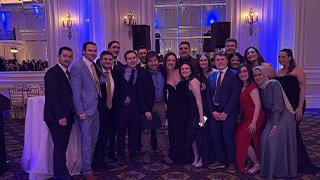Rose Mercadante Chemistry Seminar Series
Thursday, August 25, 2016
The Department of Chemistry and Biochemistry Rose Mercadante Seminar Series is pleased to present the final PhD seminar presentation of Karthik Jayaraman entitled:
Adsorption and Wetting Phenomena in Well-Defined Model Mesoporous Surfaces and in Complex Catalyst Loaded Metal Oxides.
Abstract:
Pore wetting is critical to many applications of mesoporous adsorbents, catalysts, and separation materials. In this work, we employed the combined vapor adsorption study using nitrogen (77K) and water (293K) isotherms to evaluate the water contact angles for a series of ordered mesoporous silicas (ex:SBA-15). The proposed method of contact angle relies on the statistical film thickness (t-curve) of the adsorbed water. There were no t-curves for water for dehydroxylated or hydrophobic surfaces in literature and we addressed this issue by measuring t-curves for a series of model surfaces with known and varying silanol coverage. Using the radius of menisci ((H 2O)), statistical film thickness t(H 2O) from water isotherm, and the true radius of pores (r p(N 2)), from nitrogen isotherms, the water contact angle inside pores were calculated. As it was anticipated, the results obtained showed that the silica pore contact angles were strongly influenced by the number of the surface silanol groups and, therefore, by the thermal and hydration treatments of silicas.
Phthalocyanines (Pcs) present an interesting class of catalytically active of molecules with unique spectroscopic, photoelectric, and sometimes magnetic properties The main objective of this work is to prepare Pcs entrapped solid surfaces that will eventually be used as a support bed for catalytic reactions. The combined vapor adsorption study that was developed previously, was leveraged to characterize the bare Pcs and also Pcs loaded on to metal oxide surfaces. The combined vapor adsorption study enabled in understanding the affinity of Pcs towards water vapor i.e number of water molecules adsorbed per Phthalocyanine molecule was obtained. This information is very relevant towards using Pcs as catalyst as water vapor is guaranteed to be present in most of the catalytic reactions. The initial work was focused on adsorption and entrapment of phthalocyanine molecules into the pores of metal oxides. Several techniques namely adsorption by pore filling, solution adsorption, encapsulation of adsorbed Pcs were attempted to load or entrap Pcs inside the pores of the metal oxides. Finally, a novel procedure was used to obtain a mesoporous alumina material with phthalocyanines entrapped inside the pores.
Karthik Jayaraman got his B.Tech degree in Chemical Engineering from University of Madras in 2001. In 2001 he joined Clarkson University, Potsdam NY and obtained his MS degree in Chemical Engineering in 2003 (worked on Chemical Vapor deposition of thin films for his MS thesis). In 2003 he joined University of Maryland, College Park and obtained his MS in Chemistry in 2005. His thesis work at UMCP was on "Observing Capillarity in hydrophobic silica nanotubes" (2005 JACS publication). He started working for Bristol MyersSquibb in 2005 and continues to work there as Research Scientist. He joined Seton Hall in Fall 2008 and from 2009 Fall, he has been working in Dr.Fadeev's research group.





